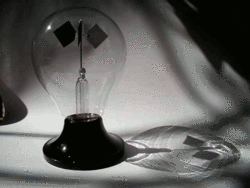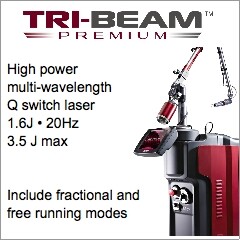What is a picosecond laser?

Photo-thermal or photo-mechanical?
A picosecond is a trillionth of a second, 10-12 s, or a millionth of a millionth of a second. Commercial picosecond medical lasers do not actually achieve this short of a pulse. The devices from most manufacturers deliver pulses that are actually several hundred picoseconds or just under one nanosecond, a billionth of a second, 10-9 s. Traditional Q-switched lasers generate nanosecond pulses at about 2 to 20 nanoseconds, 10-8 s, so the difference is not near as much as the picosecond laser manufacturers promote. These are actually sub-nanosecond devices and the most popular devices deliver 0.5 to 0.8 nanoseconds.
How different is 0.8 nanoseconds from the 4 to 8 nanosecond pulses Q-switched lasers deliver?
The marketing literature and papers from the sub-nanosecond laser manufacturers do not compare results of the picosecond devices to a premium Q-switched laser like the Jeisys Tri-Beam high energy system. The physics property that determines the effect on a target is the rate of energy delivered, not the pulse width. The manufacturers seem to misunderstand the physics or describe it incorrectly, and this has caused a misunderstanding of the laser tissue interaction among doctors.
If enough energy is delivered fast enough and absorbed by the target then the target can undergo rapid differential thermal expansion and shatter in to fragments small enough to be cleared by phagocytosis. The sub-nanosecond systems deliver one fifth the total energy in one tenth the time , or 250 Joules per nanosecond compared to 125 Joules per nanosecond of premium Q-Switched systems. The clearance rates of the sub-nanosecond systems compared to the Tri-Beam with beam shaping optics appear to be similar. The actual physical property that should be specified is the integral of the pulse rise time, NOT the pulse width. The pulse width has minor effect on clearance.
Visualize this by considering a picosecond pulse shattering an ink particle. The pulse is very narrow and the ink particle shatters somewhere near the peak of the pulse. Once the particle is shattered it does not matter if the power level of the pulse goes down to zero or stays on for another nanosecond or even a second. The particle shatters because the fast absorption of the laser energy causes a fast temperature rise. The temperature falls slowly by diffusion. As a result is the pulse rise time and peak power level that is important when comparing different lasers.
What is the difference between a photo-mechanical and a photo-thermal effect?
The leading picosecond laser is marketed as creating a photo-mechanical effect as opposed to Q-switched lasers photo-thermal effect. In fact photons from medical devices interact with tissue in only three ways: photo-thermal, photo-chemical, and photo-ionizing. Photo-ionization occurs when UV light or very high energy lasers strip electrons from their atomic orbitals and ionize molecules typically leading to unwanted biological reactions. Some visible and UV light can cause photo-chemical interactions by providing enough energy to molecules to directly influence chemical process such as vitamin D production, tanning, and photosynthesis. The photons from infrared devices and most visible lasers are converted to heat in a photo-thermal process. If the energy is delivered fast enough a thermal shock and resulting mechanical stress occurs in the target. This can result in a shattering of the target with a resulting acoustic shock wave. This process is how Q-switched lasers clear tattoos. The sub-nanosecond lasers operate the same way, but with shorter pulse can create thermal stress in smaller particles. The term photo-mechanical is a misnomer and is meant to make people believe it is a different process than the photo-thermal shock caused by high quality Q-switched lasers such as the Tri-Beam.
Picosecond laser 2x improvement in tattoo clearance vs. the results of QS lasers
 These claims are made after comparing the new picosecond systems to older Q-switched systems. Clients report clearance using higher energy Q-switched lasers with 60% of the number of treatments that were required from their previous Q-Switched systems. These clearance rates are comparable to the claims of picosecond laser manufacturers. The difference is primarily the beam shaping optics and higher energy of premium Q-switch laser giving them almost 80% more coverage per treatment making them far more effective than the older Q-Switch models that the picoseconds lasers have been compared to.
These claims are made after comparing the new picosecond systems to older Q-switched systems. Clients report clearance using higher energy Q-switched lasers with 60% of the number of treatments that were required from their previous Q-Switched systems. These clearance rates are comparable to the claims of picosecond laser manufacturers. The difference is primarily the beam shaping optics and higher energy of premium Q-switch laser giving them almost 80% more coverage per treatment making them far more effective than the older Q-Switch models that the picoseconds lasers have been compared to.
What wavelength is needed?
Two or three. There are hundreds of pigments used in the various amateur and professional tattoos that patients wish to alter or remove. Each type of pigment has an absorption spectrum and one or two wavelengths will be the most effective in clearing them. Tri-Beam has 4 different wavelengths of laser energy and can clear almost any color pigment. The sub-nanosecond or picosecond devices come in single or dual wavelength models. Tri-Beam offers the complete solution in a single platform for about 1/3 the cost and most likely much higher up-time and patient throughput.
What about cost and reliability?
There is no long term track record for reliability of the new picosecond lasers, but one presenter at a major conference reported that he needed an engineer in his office almost full-time during the studies he performed for the manufacturer in order to keep it operating properly. We expect the reliability to improve however these sub-nanosecond devices are far more delicate than Q-switched technology, which has been evolving for 30 years with thousands of Q-switched devices installed worldwide. Jeisys lasers are made in Korea and are some of the best engineered and most reliable systems in the market. The cost effective engineering and production of high tech Korean products are about 1/3 the cost of the sub-nanosecond devices from other manufacturers.
(revised 3/22/2017)
